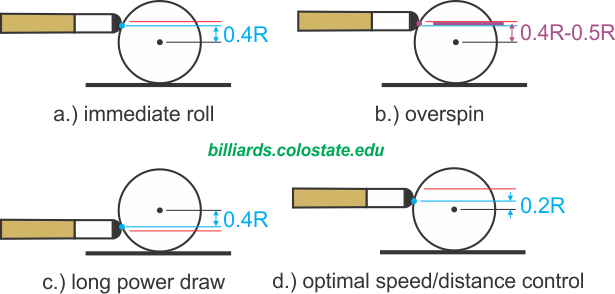What tip height is required for a rolling cue ball, and is it possible to get more spin than natural roll?
Good explanations and illustrations of this can be found in the following instructional article:
- “How High or Low Should You Hit the Cue Ball?” (BD, September, 2011)
Here’s an illustration from the article showing some key tip reference heights:

Concerning the amount of center ball offset required for immediate natural roll, the answer (and analysis) are in TP 4.2. The technical term for the contact point for natural roll is “the center of percussion.” The required contact point offset from center ball is:
2/5 R = 2/5 (9/8 in) = 9/20 in = .45 in
The maximum recommended offset, beyond which miscues are very likely, is usually cited in the range:
1/2 in to 9/16 in = .50 in to .56 in
Therefore, follow (topspin) in excess of natural roll is possible (i.e., .45 is less than .5), but not by much. This is called overspin. With overspin, the CB will accelerate (i.e., speed up) as the spin wears off until the amount of topspin degrades to the “natural roll” amount. For more information, see “Coriolis was brilliant … but he didn’t have a high-speed camera – Part IV: maximum cue tip offset” (BD, October, 2005). The following video provides visual proof of off-the-tip overspin, and provides more explanation:
Also, NV B.36 shows a simple experiment to show how difficult it is to achieve overspin without miscuing.
Now, after a CB hits an OB, it can most certainly have overspin. For example, in HSV 4.3 and NV 4.8 the CB has topspin. Before it hits the OB, the amount of topspin is the natural rolling amount (i.e., there is no “overspin”). After the CB hits the OB, the CB has more topspin than the natural rolling amount (i.e., there is “overspin”). This is what causes the CB to “follow” the OB to the rail. After rebound off the rail, some of the spin is retained (which looks like bottom spin now) causing the CB to draw back to the rail.
The reason for extreme follow effects is all about speed. For a fast natural roll follow shot, the topspin angular speed goes up as the ball linear speed goes up. And for small cut angle shots, the cue ball loses most of its linear speed and retains most of the spin, causing significant follow effects. HSV 4.1-4.3 illustrate the principles fairly well.
For more info and illustrations dealing with ball sliding and rolling, with and without sidespin, see:
Dr. Dave keeps this site commercial free, with no ads. If you appreciate the free resources, please consider making a one-time or monthly donation to show your support:
